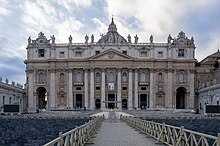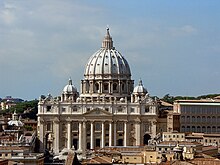Catholic Church in Europe

| Part of a series on the |
| Catholic Church by country |
|---|
 |
|
|
The Catholic Church in Europe is part of the worldwide Catholic Church in full communion with the Holy See in Rome, including represented Eastern Catholic missions. Demographically, Catholics are the largest religious group in Europe.
Demographics
[edit]
About 35%[1] of the population of Europe today is Catholic, but only about a quarter of all Catholics worldwide reside in Europe. This is due in part to the movement and immigration at various times of largely Catholic European ethnic groups (such as the Irish, Italians, Poles, Portuguese, and Spaniards) to continents such as the Americas and Australia. Furthermore, Catholicism has been spread outside Europe through both historical Catholic missionary activity, especially in Latin America, and the past colonization and conversion of native people by Catholic European countries, specifically the Spanish, Portuguese, French and Belgian colonial empire, in regions such as South America, the Caribbean, Central Africa and West Africa, and Southeast Asia.[2]
The Holy See and the European episcopal conferences
[edit]Holy See–European Union relations
[edit]As the Vatican State is a theocracy, it cannot become a member of the European Union. However, traditionally there are very strong ties of the Holy See with the only neighboring country of the Vatican City, Italy and also with the European Union. Since 1970 the European Union accredits an official representative from the Holy See (an Apostolic Nuncio) to the EU. Even though the Vatican City is not an official member of the European Union, it has adopted the Euro as its currency and has open borders with the Schengen Area.
Statements of the Holy See and other dignitaries of the Catholic Church on the European integration
[edit]In 2016 Pope Francis was awarded with the Charlemagne prize. During his speech of thanks Pope Francis criticized a "crisis of solidarity"[3] in Europe and condemned "national self-interest, renationalization and particularism".[3]
In December 2018 Cardinal Reinhard Marx, archbishop of Munich and Freising and former president of COMECE, called for a deeper European integration and condemned the harmful consequences of nationalism.[4][5][6]
The Council of the Bishops' Conferences of Europe (CCEE)
[edit]The Council of the Bishops' Conferences of Europe (Latin: Consilium Conferentiarum Episcoporum Europae) (CCEE) is a conference of the presidents of the 33 Roman Catholic episcopal conferences of Europe, the Archbishop of Luxembourg, the Archbishop of Monaco, Maronite Catholic Archeparch of Cyprus, the Roman Catholic Bishop of Chişinău, the Ruthenian Catholic Eparch of Mukacheve, and the Apostolic Administrator of Estonia.[7] The CCEE Secretariat is located in St. Gallen, Switzerland.
The Commission of the Bishops' Conferences of the European Community (COMECE)
[edit]The Commission of the Bishops' Conferences of the European Community (Latin: Commissio Episcopatuum Communitatis Europaeae; COMECE) is the association of Catholic Church episcopal conferences in member states of the European Union (EU) which officially represents those episcopal conferences at EU institutions.[8][9] COMECE bishops are delegated by Catholic episcopal conferences in EU member states and has a permanent Secretariat in Brussels, Belgium.[8][10] It was established in 1980 and replaced the European Catholic Pastoral Information Service (SIPECA, 1976–1980). Discussions during the 1970s about creating an episcopal conferences' liaison organization to the European Community led to the decision, on the eve of the 1979 European Parliament election, to establish COMECE.[11]
Important European Catholic lay organizations
[edit]European Catholic youth organizations
[edit]Fimcap Europe (International Federation of Catholic Parochial Youth Movements): Fimcap is an umbrella organization for catholic youth organizations, especially for youth organizations which are based at parish level. (See also: Fimcap Europe)
MIJARC Europe (International Movement of Catholic Agricultural and Rural Youth): MIJARC Europe is a platform representing the catholic, agricultural and rural youth movements in Europe.
Other important Catholic lay organizations
[edit]CIDSE (International Cooperation for Development and Solidarity): CIDSE is an umbrella organization for Catholic development agencies from Europe and North America.
World Movement of Christian Workers consists of Catholic workingmen and workingwomen.
Important sites for the Catholic Church in Europe
[edit]
Vatican City and Rome
[edit]According to the Catholic tradition, Saint Peter, one of the Twelve Apostles of Jesus Christ and leader of the early church, was crucified and buried in Rome under Emperor Nero Augustus Caesar. On the place supposed to be the burial site of Saint Peter the Saint Peter's Basilica was built. Rome is also the residence city of the Pope, the leader of the Catholic Church, who at the same time is also the Bishop of Rome. Until today the Pope rules over an ecclesiastical state, the Vatican City, which encompasses 44 hectares of the city area. Rome hosts also the Papal Major basilicas. Besides the Saint Peter's Basilica there are three other Major basilicas: Archbasilica of Saint John Lateran, Basilica of Saint Paul Outside the Walls and Basilica di Santa Maria Maggiore.
Santiago de Compostela
[edit]One of the most important and famous sites for pilgrimages for the Catholic Church is Santiago de Compostela in Galicia, Spain. The cathedral of the city hosts the shrine of Saint James, one of the Twelve Apostles of Jesus, and traditionally considered the first apostle to be martyred. Santiago de Compostela is the final destination of the Way of Saint James (Galician: O Camiño de Santiago).
Assisi
[edit]Assisi, a town in the Umbria region in Italy, hosts two more papal basilicas: the Basilica of San Francesco d'Assisi and the Basilica of Santa Maria degli Angeli. The Basilica of San Francesco d'Assisi is the mother church of the Order of Friars Minor, commonly known as the "Franciscan Order". Assisi is the town in which the founder of the order, Saint Francis of Assisi, was born and died.
See also
[edit]- Catholic Church by country
- Catholic Church in Africa
- Catholic Church in Asia
- Catholic Church in North America
- Catholic Church in Latin America
- Catholic Church in Oceania
- List of Catholic dioceses in Europe
References
[edit]- ^ PEW Report: Global Christianity Archived August 5, 2013, at the Wayback Machine
- ^ "Number of Catholics on the Rise". Zenit News Agency. 27 April 2010. Archived from the original on 27 July 2010. Retrieved 2 May 2010.. For greater details on numbers of Catholics and priests and their distribution by continent and for changes between 2000 and 2008, see "Annuario Statistico della Chiesa dell'anno 2008". Holy See Press Office. 27 April 2010. Retrieved 2 May 2010.[permanent dead link] (in Italian)
- ^ a b "Pope Francis tells Europe, 'I Have a Dream' - Crux". 2016-05-06. Retrieved 2016-07-24.
- ^ München, Erzbischöfliches Ordinariat. "Kardinal Marx will stärkere Integration Europas". www.erzbistum-muenchen.de (in German). Retrieved 2018-12-04.
- ^ "Christen müssen sich für Europa ei..." rtl.de (in German). Archived from the original on 2018-12-03. Retrieved 2018-12-04.
- ^ "Kardinal Marx: Nationalismus, das bedeutet Krieg". katholisch.de (in German). Retrieved 2018-12-04.
- ^ "Presentation". ccee.eu. St. Gallen: Consilium Conferentiarium Episcoporum Europae. Archived from the original on 2016-01-07. Retrieved 2016-05-02.
- ^ a b "Secretariat of COMECE (Commission of the Episcopates of the European Community)". ec.europa.eu. European Commission. Joint Transparency Register Secretariat. 2016-04-12. Transparency Register id: 47350036909-69. Archived from the original on 2016-05-02. Retrieved 2016-05-02.
- ^ Turner, Frank (2013). "The Roman Catholic Church and the European institutions: dialogue and advocacy at the European Union". In Leuştean, Lucian N. (ed.). Representing religion in the European Union: does God matter?. Routledge studies in religion and politics. London [u.a.]: Routledge. pp. 77, 82–83. ISBN 9780415685047.
- ^ "Who we are". comece.eu. Brussels, BE: Commission of the Bishops' Conferences of the European Community. Archived from the original on 2016-04-01. Retrieved 2016-05-03.
- ^ "Our history". comece.eu. Brussels, BE: Commission of the Bishops' Conferences of the European Community. Archived from the original on 2016-05-03. Retrieved 2016-05-03.
Further reading
[edit]- Bireley, Robert. The Refashioning of Catholicism, 1450–1700: A Reassessment of the Counter Reformation (1999)
- Burson, Jeffrey D., and Ulrich L. Lehner. Enlightenment and Catholicism in Europe: A Transnational History (2014)
- Chamedes, Giuliana. A Twentieth-Century Crusade: The Vatican’s Battle to Remake Catholic Europe (Harvard UP, 2019)
- CIA Factbook "Field Listing - Religions". Archived from the original on June 13, 2007. Retrieved 2007-04-17.
- Gehler, Michael, and Wolfram Kaiser, eds. Christian Democracy in Europe since 1945 (Routledge, 2004)
- Kent, Peter C. and J.F. Pollard, eds. Papal Diplomacy in the Modern Age (Praeger 1994),
- Kselman, Thomas, and Joseph A. Buttigieg, eds. European Christian Democracy: Historical Legacies and Comparative Perspectives (Notre Dame University Press, 2003)
- Kosicki, Piotr H. Catholics on the Barricades: Poland, France, and “Revolution,” 1891-1956 (Yale University Press, 2018) multiple online reviews
- Latourette, Kenneth Scott. A history of expansion of Christianity. vol 4. The great century: in Europe and the United States of America; A.D. 1800-A.D. 1914 (1941)
- Latourette, Kenneth Scott. Christianity in a Revolutionary Age, I: The Nineteenth Century in Europe: Background and the Roman Catholic Phase (1969)
- Latourette, Kenneth Scott. Christianity in a Revolutionary Age, IV: The Twentieth Century in Europe: The Roman Catholic, Protestant, and Eastern Churches (1958)
- MacCulloch, Diarmaid. Christianity: The First Three Thousand Years (2011)
- Misner, Paul. Social Catholicism in Europe: From the Onset of Industrialization to the First World War (1991)
